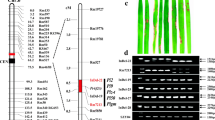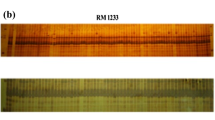Abstract
Identification of the PCR markers tightly linked to genes that encode important agronomic traits is useful for marker-assisted selection (MAS). The rice Pi5(t) locus confers broad-spectrum resistance to Magnaporthe grisea, the causal agent of rice blast disease. It has been hypothesized that the Pi5(t) locus carries the same gene as that encoded by the Pi3(t) and Pii(t) loci. We developed three PCR-based dominant markers (JJ80-T3, JJ81-T3, and JJ113-T3) from three previously identified BIBAC clones—JJ80, JJ81, and JJ113—that are linked to the Pi5(t) locus. PCR analysis of 24 monogenic lines revealed that these markers are present only in lines that carry Pi5(t), Pi3(t), and Pii(t). PCR and DNA gel-blot analysis of candidate resistance lines using JJ80-T3, JJ81-T3, and JJ113-T3 indicated that Tetep is the likely donor of Pi5(t). Of the 184 rice varieties tested, 34 carried the JJ80-T3-, JJ81-T3-, and JJ113-T3-specific bands. Disease evaluation of those 34 varieties revealed that all conferred resistance to PO6-6. The genomic structure of three of these resistant varieties (i.e., IR72, Taebaeg, Jahyangdo) is most similar to that of Pi5(t). Our results demonstrate the usefulness of the JJ80-T3, JJ81-T3, and JJ113-T3 markers for MAS for M. grisea resistance.




Similar content being viewed by others
References
Ahn SW (1994) International collaboration on breeding for resistance to rice blast. In: Zeigler RS, Leong SA, Teng PS (eds) Rice blast disease. CAB Int/IRRI, Wallingford/Manila, pp 137–153
Ahn SW (2000) Spatial and temporal stability of genetic resistance to rice blast. In: Tharreau D, Lebrun MH, Talbot NJ, Notteghem JL (eds) Advances in rice blast research. Kluwer, Dordrecht, pp 162–171
Ahn S-N, Kim Y-K, Hong H-C, Han S-S, Kwon S-J, Choi H-C, Moon H-P, McCouch SR (2000) Molecular mapping of a new gene for resistance to rice blast (Pyricularia grisea). Euphytica 116:17–22
Bonman JM, Mackill DJ (1988) Durable resistance to rice blast. Oryza 25:103–110
Bonman JM, Vergel de Dios TI, Khin MM (1986) Physiological specialization of Pyricularia oryzae in the Philippines. Plant Dis 70:767–769
Chauhan RS, Farman ML, Zhang HB, Leong SA(2002) Genetic and physical mapping of a rice blast resistance locus, Pi-CO39(t), that corresponds to the avirulence gene AVR1-CO39 of Magnaporthe grisea. Mol Gen Genomics 267:603–612
Chen D-H, Ronald PC (1999) A rapid DNA minipreparation method suitable for AFLP and other PCR applications. Plant Mol Biol Rep 17:53–57
Chen D-H, Zeigler RS, Ahn SW, Nelson RJ (1996) Phenotypic characterization of the rice blast resistance gene Pi2(t). Plant Dis 80:52–56
Chen D-H, dela Viña M, Inukai T, Mackill DJ, Ronald PC, Nelson RJ (1999) Molecular mapping of the rice blast resistance gene, Pi44(t), in a line derived from a durably resistant rice cultivar. Theor Appl Genet 98:1046–1053
Chen D-H, Nelson RJ, Wang G-L, Mackill DJ, Ronald PC (2000) Use of DNA markers in introgression and isolation of genes associated with durable resistance to rice blast. In: Tharreau D, Lebrun MH, Talbot NJ, Notteghem JL (eds) Advances in rice blast research. Kluwer, Dordrecht, pp 17–27
Choi HC, Hwang HG, Hong HC, Kim YG, Kim HY, Kang KH, Yea JD, Shin YS, Choi YH, Cho YC, Baek MK, Lee JH, Yang CI, Jeong KH, Ahn SN, Yang SJ, Moon HP (2002) A lodging tolerance and dull cultivar Baekjinju. Treatises Crop Res 3:59–65
Conaway-Bormans CA, Marchetti MA, Johnson CW, McClung AM, Park WD (2003) Molecular markers linked to the blast resistance gene Pi-Z in rice for use in marker-assisted selection. Theor Appl Genet 107:1014–1020
Han SS (2001) Improvement of disease evaluation system and classification of rice blast isolates. In: Proc 1st Workshop Rice Blast. Milyang, pp 1–19
Hittalmani S, Parco A, Mew TV, Zeigler RS, Huang N (2000) Fine mapping and DNA marker-assisted pyramiding of the three major genes for blast resistance in rice. Theor Appl Genet 100:1121–1128
Imbe T, Tsunematsu H, Kato H, Khush GS (2000) Genetic analysis of blast resistance in IR varieties and resistant breeding strategy. In: Tharreau D, Lebrun MH, Talbot NJ, Notteghem JL (eds) Advances in rice blast research. Kluwer, Dordrecht, pp 1–8
Inukai T, Nelson RJ, Zeigler RS, Sarkarung S, Mackill DJ, Bonman JM, Takamure I, Kinoshita T (1994) Allelism of blast resistance genes in near-isogenic lines of rice. Phytopathology 84:1278–1283
Inukai T, Zeigler RS, Sarkarung S, Bronson M, Dung LV, Kinoshita T, Nelson RJ (1996) Development of pre-isogenic lines for rice blast-resistance by marker-aided selection from a recombinant inbred population. Theor Appl Genet 93:560–567
Jeon J-S, Chen D, Yi G-H, Wang GL, Ronald PC (2003) Genetic and physical mapping of Pi5(t), a locus associated with broad-spectrum resistance to rice blast. Mol Gen Genomics 269:280–289
Jiang J, Wang S (2002) Identification of a 118-kb DNA fragment containing locus of blast resistance gene Pi2-2(t) in rice. Mol Gen Genomics 268:249–252
Kiyosawa S (1967) The inheritance of resistance of Zenith type varieties of rice to the blast fungus. Jpn J Breed 17:99–107
Kiyosawa S (1973) Gene analysis of indica type varieties. In: Basic studies on breeding measures to counter explosive outbreaks of blast epidemics in resistant rice varieties. Ministry of Agriculture, Forestry and Fisheries Council, Tokyo, pp 47–61
Lee EJ, Cho SY (1990) Variation in races of rice blast disease and varietal resistance in Korea. In: Focus on irrigated rice. Seoul, pp 27–31
Mackill DJ, Bonman JM (1992) Inheritance of blast resistance in near-isogenic lines of rice. Phytopathology 82:746–749
McCouch SR, Nelson RJ, Tohme J, Zeigler RS (1994) Mapping of blast resistance genes in rice. In: Zeigler RS, Leong SA, Teng PS (eds) Rice blast disease. CAB Int/IRRI, Wallingford/Manila, pp 167–186
Naqvi NI, Chattoo BB (1996) Molecular genetic analysis and sequence characterized amplified region-assisted selection of blast resistance in rice. In: IRRI (ed) International Rice Research Institute, Rice Genetics III. Proc 3rd Int Rice Genet Symp. IRRI, Manila, pp 507–572
Ou SH (1979) Breeding rice for resistance to blast, a critical view. In: IRRI (ed) Proc Rice Blast Workshop. IRRI, Manila, pp 79–137
Ou SH (1985) Rice diseases, 2nd edn. Commonwealth Mycological Institute, Kew
Pan Q-H, Hu Z-D, Takatoshi T, Wang L (2003) Fine mapping of the rice blast resistance gene Pi15, linked to Pii, on rice chromosome 9. Acta Bot Sin 45:871–877
Sambrook J, Fritsch EF, Maniatis T (1989) Molecular cloning: a laboratory manual. Cold Spring Harbor Press, New York
Tsunematsu H, Yanoria MJT, Ebron LA, Hayashi N, Ando I, Kato H, Imbe T, Khush GS (2000) Development of monogenic lines of rice for blast resistance. Breed Sci 50:229–234
Wang G-L, Mackill DJ, Bonman JM, McCouch SR, Champoux MC, Nelson RJ (1994) RFLP mapping of genes conferring complete and partial resistance to blast in a durably resistant rice cultivar. Genetics 136:421–1434
Yu ZH, Mackill DJ, Bonman JM, McCouch SR, Guiderdoni E, Notteghem JL, Tanksley SD (1996) Molecular mapping of genes for resistance to rice blast (Pyricularia grisea Sacc.). Theor Appl Genet 93:859–863
Yu J, Hu S, Wang J, Wong GK, Li S, Liu B, Deng Y, Dai L, Zhou Y, Zhang X, Cao M, Liu J, Sun J, Tang J, Chen Y, Huang X, Lin W, Ye C, Tong W, Cong L, Geng J, Han Y, Li L, Li W, Hu G, Huang X, Li W, Li J, Liu Z, Li L, Liu J, Qi Q, Liu J, Li L, Li T, Wang X, Lu H, Wu T, Zhu M, Ni P, Han H, Dong W, Ren X, Feng X, Cui P, Li X, Wang H, Xu X, Zhai W, Xu Z, Zhang J, He S, Zhang J, Xu J, Zhang K, Zheng X, Dong J, Zeng W, Tao L, Ye J, Tan J, Ren X, Chen X, He J, Liu D, Tian W, Tian C, Xia H, Bao Q, Li G, Gao H, Cao T, Wang J, Zhao W, Li P, Chen W, Wang X, Zhang Y, Hu J, Wang J, Liu S, Yang J, Zhang G, Xiong Y, Li Z, Mao L, Zhou C, Zhu Z, Chen R, Hao B, Zheng W, Chen S, Guo W, Li G, Liu S, Tao M, Wang J, Zhu L, Yuan L, Yang H (2002) A draft sequence of the rice genome (Oryza sativa L. ssp. indica). Science 296:79–92
Zeigler RS, Tohme J, Nelson J, Levy M, Correa F (1994) Linking blast population analysis to resistance breeding: a proposed strategy for durable resistance. In: Zeigler RS, Leong SA, Teng PS (eds) Rice blast disease. CAB Int/IRRI, Wallingford/Manila, pp 267–292
Zenbayashi K, Ashizawa T, Tani T, Koizumi S (2002) Mapping of the QTL (quantitative trait locus) conferring partial resistance to leaf blast in rice cultivar Chubu 32. Theor Appl Genet 104:547–552
Zhu L, Chen Y, Ling Z, Xu Y, Xu J (1993) Identification of the molecular markers linked to the blast resistance gene in rice. In: You CB, Chen ZL (eds) Agricultural biotechnology. China Science and Technology Press, Beijing, p 213
Acknowledgements
We thank Dave Mackill, Sang-Nak Ahn, Sang-Won Ahn, Kenong Xu, Tsuyoshi Inukai, Dahu Chen, Kangle Zheng, and Matt Campbell for helpful discussions, and Harold Bockelman for providing C104PKT, LAC23, PKT, and Tetep. We also thank Priscilla Licht for critical reading of the manuscript. This work was supported, in part, by grants from the Biogreen 21 Program, Rural Development Administration; from SRC for the Plant Metabolism Research Center (PMRC), Korea Science and Engineering Foundation (KOSEF) Program; from the BK21 program, Ministry of Education; and from the United States Department of Agriculture.
Author information
Authors and Affiliations
Corresponding author
Additional information
Communicated by Q. Zhang
G.Yi and S.-K. Lee contributed equally to this work.
Rights and permissions
About this article
Cite this article
Yi, G., Lee, SK., Hong, YK. et al. Use of Pi5(t) markers in marker-assisted selection to screen for cultivars with resistance to Magnaporthe grisea . Theor Appl Genet 109, 978–985 (2004). https://doi.org/10.1007/s00122-004-1707-8
Received:
Accepted:
Published:
Issue Date:
DOI: https://doi.org/10.1007/s00122-004-1707-8




